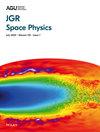Influence of Initial Proton Energy on the Nonlinear Interactions Between Ring Current Protons and He+ Band EMIC Waves
Abstract
The energy of ring current protons is believed to influence the pitch angle scattering due to electromagnetic ion cyclotron (EMIC) waves and is typically analyzed using quasi-linear theory. However, nonlinear behavior becomes significant as the wave amplitude intensifies. In this study, we aim to explore how the nonlinear behavior depends on the initial proton energy under various background plasma density conditions. The frequency of EMIC waves is 0.96ΩHe (where ΩHe is the gyrofrequency of He+ at the equator). It is found that the higher energy protons with nonlinear phase trapping experience more resonances, causing these trapped protons to move away from the loss cone more quickly compared to lower energy protons. However, the proportion of phase-trapped protons significantly decreases as the initial proton energy increases. This declining trend is more pronounced for a background plasma condition in the plasmapause than within the plasmasphere. The number of phase-trapped protons goes to zero as initial proton energy increases to above approximately 60 keV. Additionally, nonlinear phase bunching is more pronounced for lower energy protons (e.g., below 60 keV) compared to higher energy protons. As a result, both nonlinear phase trapping and phase bunching contribute to larger standard deviations in the net changes of equatorial pitch angle (Δαeq), suggesting a larger pitch agnel diffusion coefficient compared to the prediction of quasi-linear theory.

 求助内容:
求助内容: 应助结果提醒方式:
应助结果提醒方式:


